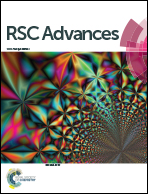Tetra-butylphosphonium arginine-based ionic liquid-promoted cyclization of 2-aminobenzonitrile with carbon dioxide†
Abstract
An easily prepared amino acid ionic liquid (AAIL) i.e. [TBP][Arg] comprising a tetra-butylphosphonium cation and an arginine anion was found to be an efficient and recyclable catalyst for the synthesis of quinazoline-2,4(1H,3H)-diones from 2-aminobenzonitriles and CO2 under solvent-free conditions. As a result, various 2-aminobenzonitriles bearing electron-withdrawing or electron-donating substituents worked well to afford quinazoline-2,4(1H,3H)-diones in excellent yields. Notably, this type of AAIL showed good stability, and could be easily recovered and reused five times without significant loss of its catalytic activity. This process represents an alternative approach for greener chemical fixation of CO2 to afford valuable compounds.


 Please wait while we load your content...
Please wait while we load your content...